SIDECAR MOTOCROSS: MOST UNDERRATED MOTORSPORT IN THE WORLD
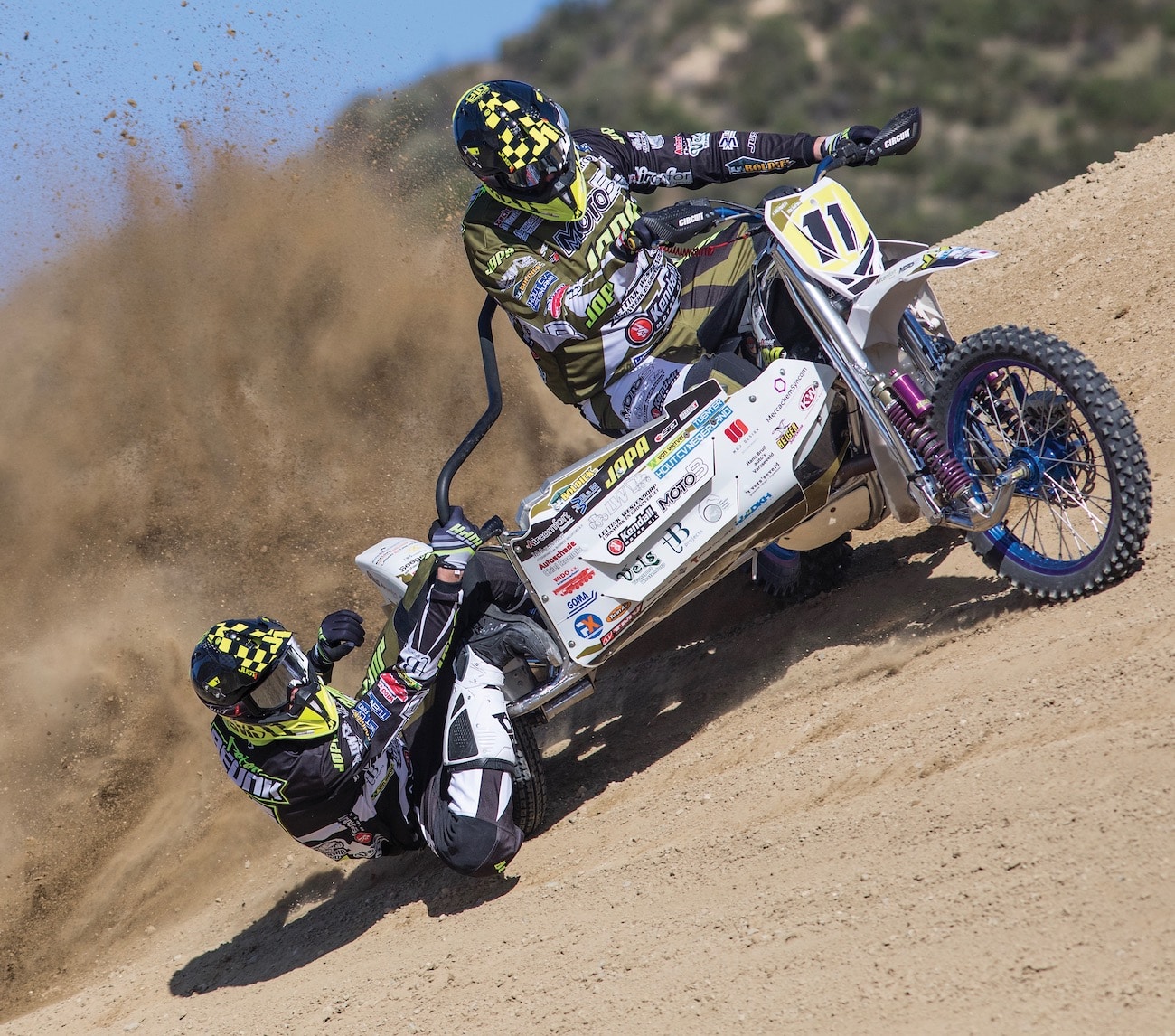 Sadly the 2020 FIM World Sidecar Championship was canceled due to coronavirus lock downs in Europe, but the MXA wrecking crew decided to take a swing at it to give sidecar fans their fill.
Sadly the 2020 FIM World Sidecar Championship was canceled due to coronavirus lock downs in Europe, but the MXA wrecking crew decided to take a swing at it to give sidecar fans their fill.
BY DARYL ECKLUND
Are you a mind reader? Can you predict people’s actions and decisions? If you can, chances are you would be good at sidecar motocross racing. Yes, you could have your own mentalist stage show in Las Vegas and make millions, or use your telepathic powers to save the world from evil, but you wouldn’t have as much fun as racing sidecars.
Take my word for it. I am not a mind reader, as you will find out later; however, I learned to work closely with my buddy and fellow MXA rider Josh Mosiman, thanks to a once-in-a-lifetime opportunity to blast around Glen Helen on a Grand Prix sidecar. On second thought, take the Vegas gig, because you will need a boatload of money to afford sidecar racing as a hobby.
“RALF COULDN’T HAVE FOUND BETTER AMBASSADORS FOR SIDECAR RACING THAN PETER AND GERT. THE BIG DRAW FOR THEM WAS GLEN HELEN’S BIGHILLS, BECAUSE THE WORLD SIDECAR MOTOCROSS CHAMPIONSHIPIS HELD ON RELATIVELY FLAT TRACKS.”
After Josh’s and my experience, I feel that sidecar motocross racing is the most underrated motorsport discipline in the world. It isn’t flashy. You can’t throw whips over the finish line, and posing for the podium photo is super crowded with six people up on the platform. And, if you are like me, you got out of stick-and-ball sports to race motocross because you liked the individual aspect of it. When you win or lose in motocross, it isn’t because your left fielder dropped a pop-up. In motocross, it is all on you, not your team.
 MXA’s Daryl Ecklund (driver) and Josh Mosiman (passenger) had to trust each other.
MXA’s Daryl Ecklund (driver) and Josh Mosiman (passenger) had to trust each other.
To tell the truth, I never gave any thought to racing sidecar motocross. In fact, I knew virtually nothing about sidecar racing until TM distributor Ralf Schmidt pitched the sidecar idea to MXA. Ralf knew a TM-sponsored sidecar team in Holland that races the FIM World Sidecar Motocross Championship series and was selling one of its TM sidecars. Ralf, who is always looking for ways to promote TM Motorcycles in America, went in with one of his California dealers to buy the rig. Ralf had the 400-pound, WSP-framed sidecar rig shipped to California, along with TM sidecar racers Peter Beunk (the passenger) and Gert Van Werven (the driver).
Jody was the only person that Josh or I knew who had ever raced a sidecar and Peter and Gert, the young Dutch sidecar aces who came to help us learn the ropes, were duly impressed that Jody had ridden with the 1981 World Sidecar Motocross Champion Ton Van Heugten at Saddleback Park in the 1980s.
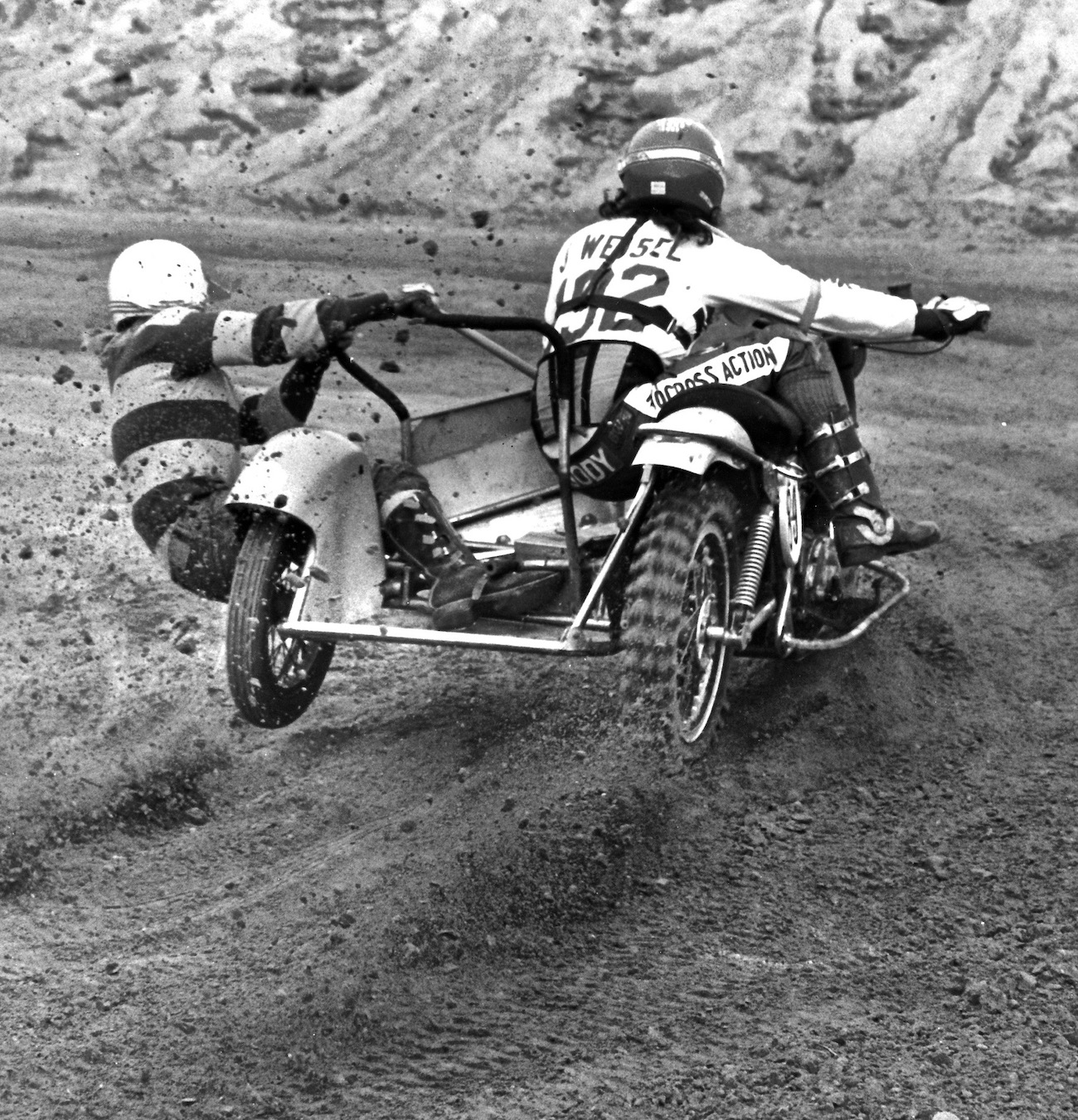 Jody had raced sidecars back in the 1980s and learned how to do it with instruction from the late Ton Van Heugten. Peter and Gert were impressed that Jody knew Ton—as he is still a hero of sidecar motocross racing.
Jody had raced sidecars back in the 1980s and learned how to do it with instruction from the late Ton Van Heugten. Peter and Gert were impressed that Jody knew Ton—as he is still a hero of sidecar motocross racing.
Why did Ralf have the two Grand Prix sidecar racers come with the rig? To teach the MXA wrecking crew how to ride it—much like Ton Van Heugten did for the MXA wrecking crew 30 years earlier. Ralf couldn’t have found better ambassadors for sidecar racing than Peter and Gert. They were thrilled to get to demonstrate sidecar racing to us at Glen Helen.
The major draw for them was Glen Helen’s big hills, because for the most part, the 2020 World Sidecar Motocross Championship is held on relatively flat Dutch, Belgian, Latvian, German, Estonian, Slovenian, Czech and French tracks. We were glad they came to the USA, because they accelerated our learning curve tenfold. Without them standing track-side to give us pointers and hands-on instruction, Josh Mosiman and I would have hit more things than we already did.
The sheer weight and power of riding a sidecar on a motocross track is intimidating. The WSP chromoly rolling chassis, which costs over $9000, and 660cc four-stroke TM engine (based on a bored-and-stroked TM 450MX engine) are the meat and potatoes of the bike. With the bike weighing 400 pounds dry and the riders around 350 pounds combined, that is a total weight of 750 pounds that the 660cc TM four-stroke has to pull around the track. The Italian-built engine pumps out 72 ponies. That would be unmanageable on a solo bike, but with the power focused more on torque than horsepower, it was about perfect for this sidecar.
“THE WEIGHT IS ALSO THE REASON SIDECAR TEAMS RUN LEADING-LINK FORKS INSTEAD OF TRADITIONAL MOTOCROSS FORKS. GERT SAID HE LIKED THE FEEL OF REGULAR FORKS BETTER; HOWEVER, THE CONVENTIONAL TELESCOPIC FORKS BREAK AND LEAK ALL THE TIME.”
According to FIM rules, World Sidecar Motocross Championship teams are allowed to have engine sizes from 500cc to 1000cc for four-strokes and 500cc to 750cc for two-strokes. There was a time when the 80-horsepower two-stroke engines reigned supreme in the sidecar world, but just like in solo motocross racing, the manufacturers are making lighter and more powerful four-strokes that can compete with the specially built 700cc Zabel two-stroke engines.
I know what you are thinking: “Why don’t they race with a 1000cc four-stroke engine if they can?” Gert and Peter had heard that question before and informed us that the weight of the 1000cc powerplant is just too much. Although the chromoly WSP frame is unbelievably strong, the weight of the smallish TM engine, two racers and the chassis is already too heavy. Gert Van Werven said that the team starts the GP season with four identical TM-powered rigs and, by the end of the GP series, the frames are starting to crack and stretch.

The weight is also the reason sidecar teams run leading-link forks instead of traditional motocross forks. Gert explained that he likes the feel of regular forks better; however, the conventional telescopic forks break and leak all the time. It was just too expensive to go that route when the budget for racing the 12-race Grand Prix series is over $100,000. That price tag includes everything save for the $20,000 machine—the travel, race fees, hotels, maintenance and parts.
Sidecar motocross is very popular in Europe, especially in Holland, Belgium and the former Eastern Block countries; but, just as in AMA Pro racing, it doesn’t pay very well except to the top two or three teams. Most of the Grand Prix riders and passengers work during the week and depend on sponsors to make ends meet. This is not a sport that racers do to make money. In truth, in many cases the money comes right out of the racers’ pockets. Imagine working Monday through Thursday, using all your vacation time to get time off to race, leaving on Thursday night after work to drive to Estonia or France or Switzerland, and then (after a day of racing) driving home in hopes of being back at work on Monday. These racers do it for the love of the sport, and at the races they are like one big family. It is a lifestyle.

Sidecars are completely custom-built. Even though Gert’s sidecar looks like a TM, that is only because the chassis builder custom makes the fittings and mounts for the TM plastics and engine. When we asked, “Why TM?” Gert had two key reasons. The first was durability. The TM 450cc four-stroke engine is overbuilt, meaning the cylinder, head and case walls are much thicker than on a KTM, Honda, Yamaha or Kawasaki. The thicker material means the engine builder can bore out the cylinder to a larger displacement without sacrificing reliability.
The second reason they choose the TM engine is that it doesn’t change a whole lot year after year. Using an engine that changes every couple years means having to build or heavily modify your existing rig every couple years, and sidecar chassis are very expensive to fabricate and modify. The TM 450MX engine has kept the same mounting points for the last seven years.
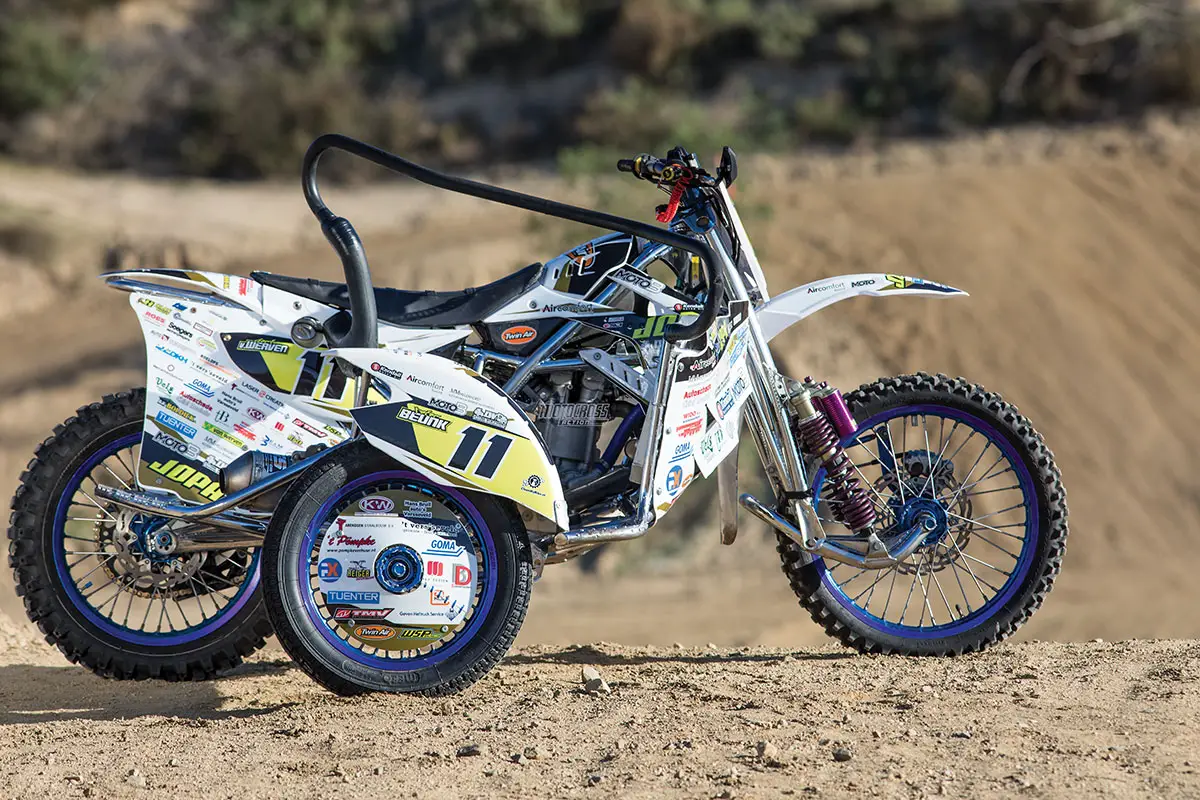
What’s it like to race a sidecar motocross rig? Believe it or not, it takes two people to control a sidecar. They are joined at the hip. The person who steers the sidecar is called the driver, even though there is no steering wheel. The passenger isn’t really a passenger at all. He is working incredibly hard to keep the sidecar rig balanced out and aimed in the right direction. Don’t call the passenger the “monkey.” That is a derogatory term given how important the passenger is to the success of the team.
“WHEN THEY TOLD JOSH NOT TO FALL OUT, I GIGGLED, ONLY TO HAVE THEM TURN TO ME AND SAY, ‘IF HE FALLS OUT, YOU ARE ON YOUR WAY TO A BIG CRASH WHEN YOU GET TO THE NEXT CORNER.’”
After a briefing on the dynamics of sidecar racing, I knew that I was not going to let Josh have a choice of being the driver or the passenger. I was going to drive. After watching Gert and Peter rip around the big Glen Helen track and seeing Peter, lying off the side of the sidecar with his back touching the ground to get the weight of the sidecar where it needed to be, I knew that wasn’t for me. It seemed dangerous. Since Josh is younger, slimmer, has more hair and I am his boss, he was going to be the passenger while I drove.
I should have been paying more attention to what Gert and Peter said in the briefing, because I thought that Josh was just going along for the ride while I carved my way around Glen Helen. That was not the case. I may have held the handlebars and thought that I was controlling where the sidecar went, but the sidecar didn’t pay any attention to my throttle and steering inputs unless Josh made it happen.

As we blasted down the starting line and headed towards the steeply banked Talladega first turn, I remembered Gert Van Werven’s initial advice when I asked how to get it around the big Glen Helen track. He said, “Just pin it!” When he said that, my eyes lit up and I looked over at Josh with a big grin on my face. So, I got on the gas hard coming into the Talladega first corner, and I could hear Josh yelling, “Slow down!” I ignored him and kept the throttle pegged. As we blasted up the banking, I had the handlebars turned as far right as they would go, but the sidecar kept going straight. I thought we were going to fly over the lip of the 70-mph Talladega banking. Just before we flew off the track, Josh saved both of us by leaning off the side of the bike to distribute the weight to make it turn. We both started laughing hysterically. It was partially from the thrill and partially from the fear. Thankfully, we were still in one piece.
“FROM THAT POINT ON, I KNEW THAT I NEEDED JOSH, AND JOSH KNEW THAT HE NEEDED ME TO GET AROUND THE TRACK WITHOUT ENDING UP UPSIDE DOWN UNDER 400 POUNDS OF SIDECAR.”
From that point on, I knew that I needed Josh, and Josh knew that he needed me to get around the track without ending up upside down under 400 pounds of sidecar. We did hit walls, go off the track and almost flipped over on more than a few occasions, but each mistake accelerated our learning curve.
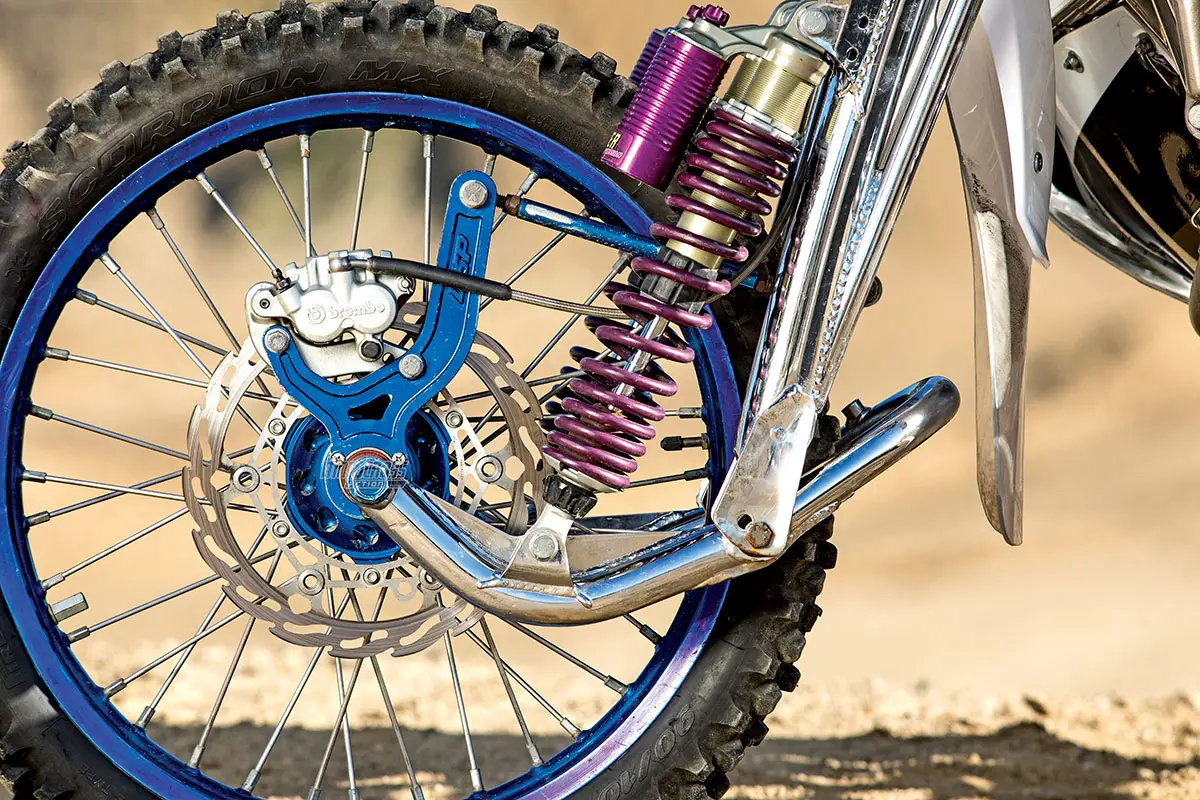
It was incredible how powerful the bike was. The 660cc powerplant put serious power to the ultra-wide 140 rear tire. The handling was awesome—that is if Josh and I were in the right positions. After every lap that we clicked off, Peter and Gert would pull us over to give us some pointers. It was Josh who was getting the most instructions. To me, the instructions were a blur, but for Josh they involved moving faster, leaning farther out of the sidecar, putting his arm around me in the left-hand turns, where to put his feet, how not to burn himself on the scorching hot exhaust and, most important, not to fall out. When they told Josh not to fall out, I giggled, only to have them turn to me and say, “If he falls out, you are on your way to a big crash when you get to the next corner.” My job was easy. I just twisted the throttle, but I wasn’t about to tell Josh that.
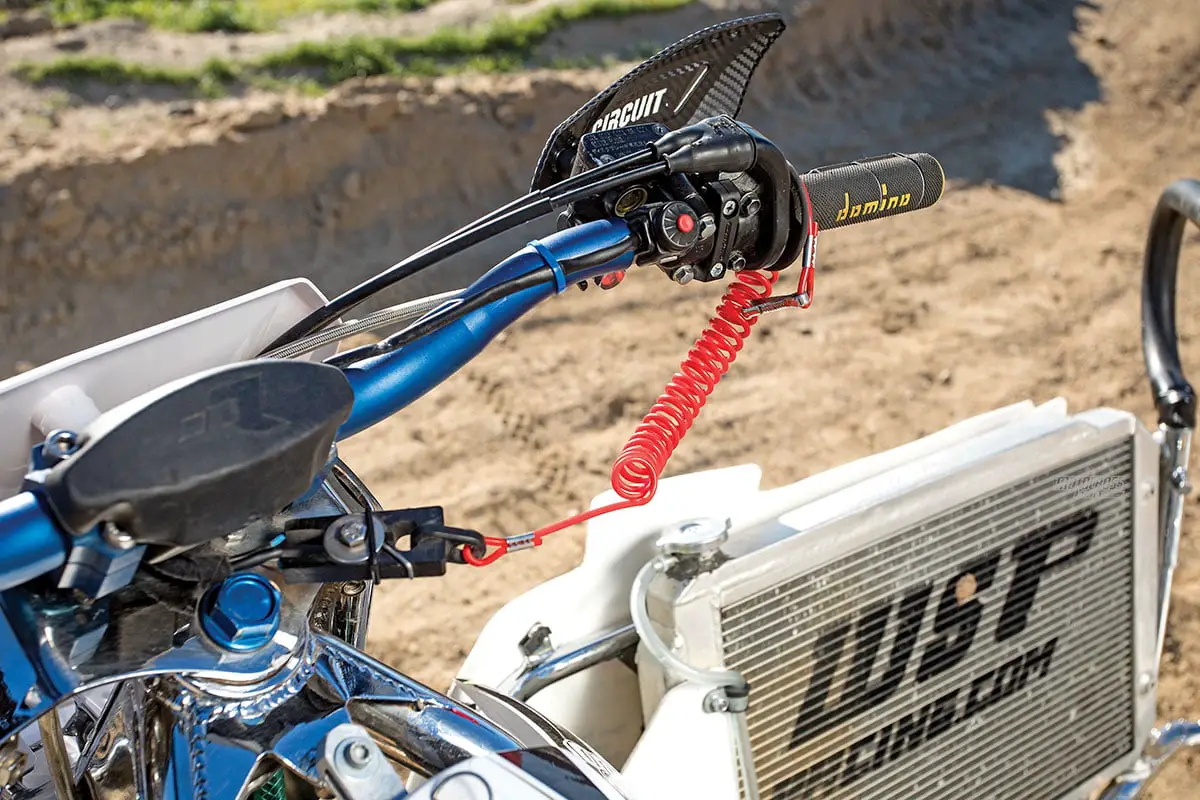
With each lap, we got better at working as one. Learning what the other was going to do at all times was paramount to staying on track. I had to start yelling if I was going to change anything. We were leery of the jumps when we heard a couple of people in the pits predict that our wheels would never leave the ground. The best part of it was Josh didn’t have a choice on the jumps we were going to attempt. I didn’t tell him or warn him; I just went for it.
The first jump we hit was 5-feet long. I could have cleared this jump on a PW 50 in my sleep, but a PW 50 doesn’t have three wheels, weigh 750 pounds and tilt at crazy angles without warning. Jumping a motocross sidecar is like jumping a Cadillac Eldorado. When we were in the air, we would start to go sideways any time that Josh wasn’t moving in the correct direction. But, we got better with each lap (and with each track-side visit with Gert and Peter).
“WE WANTED TO JUMP SOMETHING BIG. WE TOLD OUR DUTCH MENTORS THAT WE WERE GOING TO JUMP GLEN HELEN’S FINISH-LINE TABLETOP. THEY DIDN’T TRY TO TALK US OUT OF IT, BUT INSTEAD HURRIED DOWN THE TRACK TO GET A GOOD VIEW.”
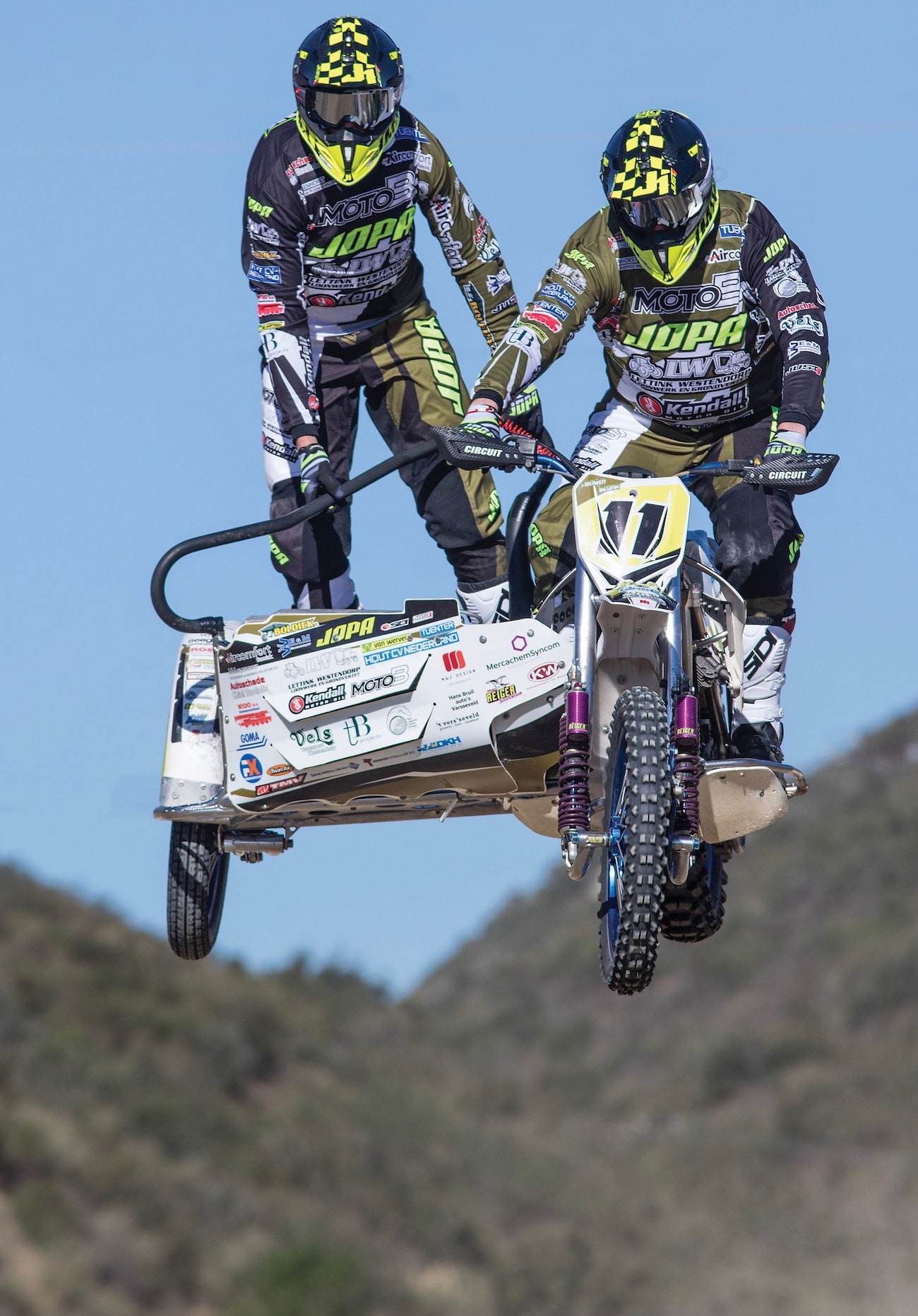 Big doubles, twice the trouble. Gert and Peter kept the WSP chassis flying straight and level.
Big doubles, twice the trouble. Gert and Peter kept the WSP chassis flying straight and level.
We wanted to jump something big. We told our Dutch mentors that we were going to jump Glen Helen’s finish-line tabletop. They didn’t try to talk us out of it, but instead hurried down the track to get a good view. Confused as to whether that was encouragement or they were trying to get out of the path of destruction, we railed the last corner and hit the jump as fast as we dared go. The bike lifted into the air in what felt like slow motion. And, it started to go sideways in ultra-slow motion. I could tell that we had the height and speed to clear the tabletop, but was unsure what would happen on the landing. We landed all crossed-up, but the sidecar snapped straight. Gert and Peter were impressed to say the least. We felt like sidecar heroes.
I felt guilty about making Josh take a beating all day long as the passenger, so I agreed to switch roles. I would be the passenger and Josh would be the driver. I was a fish out of water. I was breathing hard after the first turn. After two laps, I pounded on his back and yelled into his helmet that I’d had enough. I called it a day. My legs were burning and my hands were cramping up. I got a taste of my own medicine.
Luckily, Peter Beunk agreed to be Josh’s passenger so that Josh could get a real feel for what racing a sidecar felt like. I hate to say it, but they were amazing together. Peter’s fluid movements from side to side allowed Josh to concentrate on going fast. I knew then that I was the one who was just along for the ride; the passenger was the man in charge.
It is really hard to put into words how much fun this experience was. Riding a custom-made $20,000 machine that has all the power you need at your fingertips is a serious adrenaline rush. Having a good friend working with you to experience the same fun together is also quite the rush. Thanks, Gert and Peter, for the lessons, and Ralf for letting us break in your new ride.
Note: Sadly the 2020 World Sidecar Motocross Championship was canceled by the FIM over coronavirus concerns.




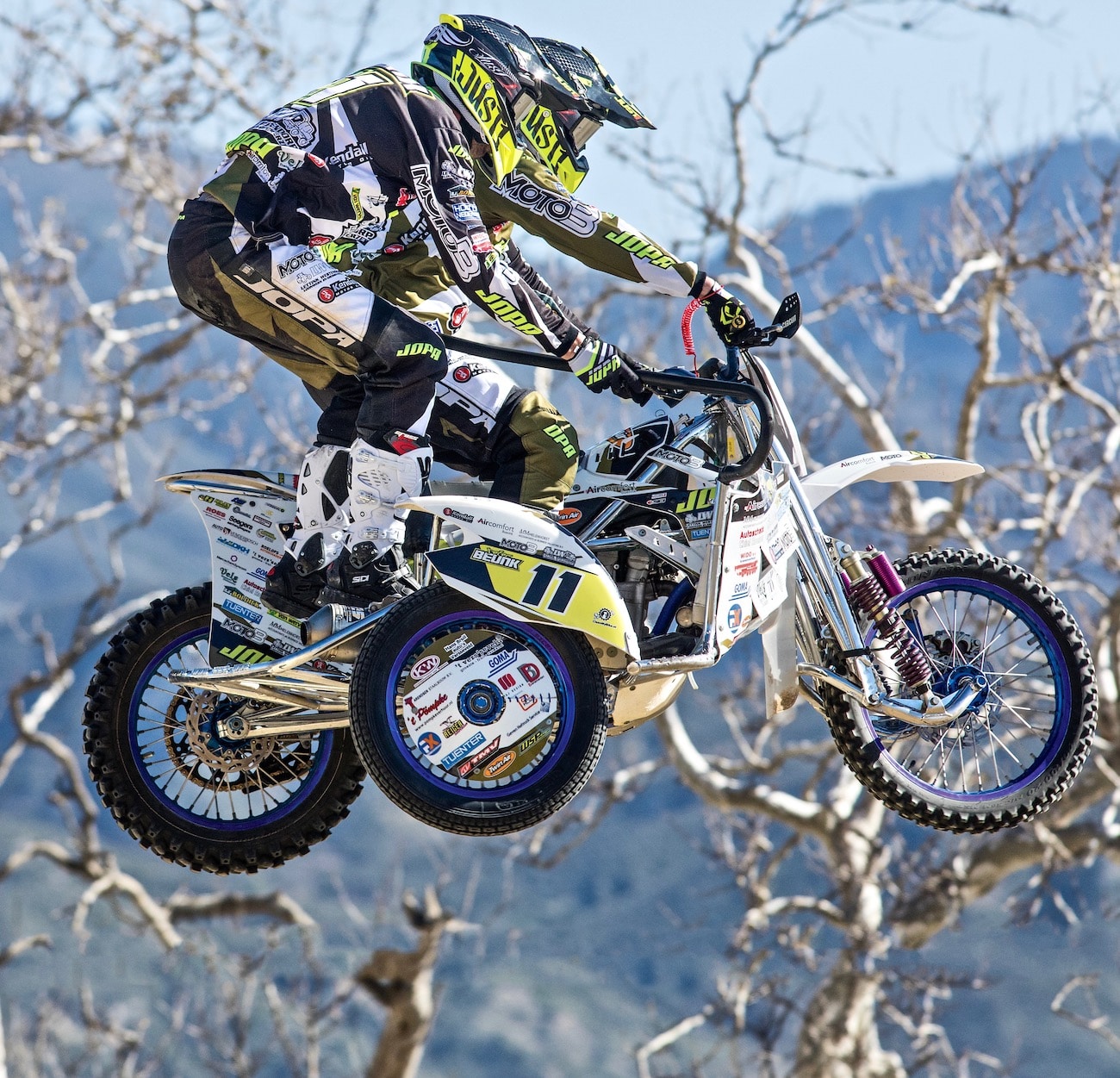
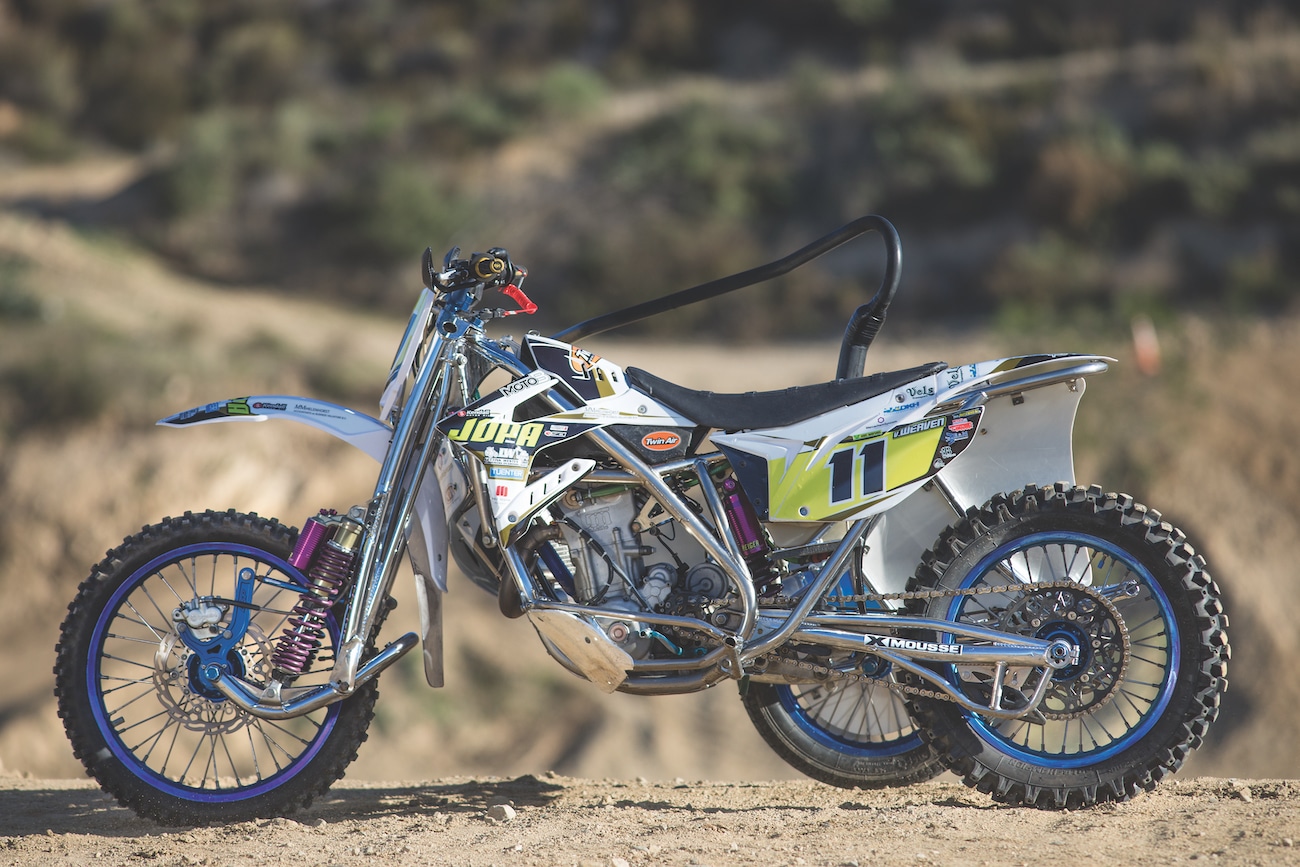
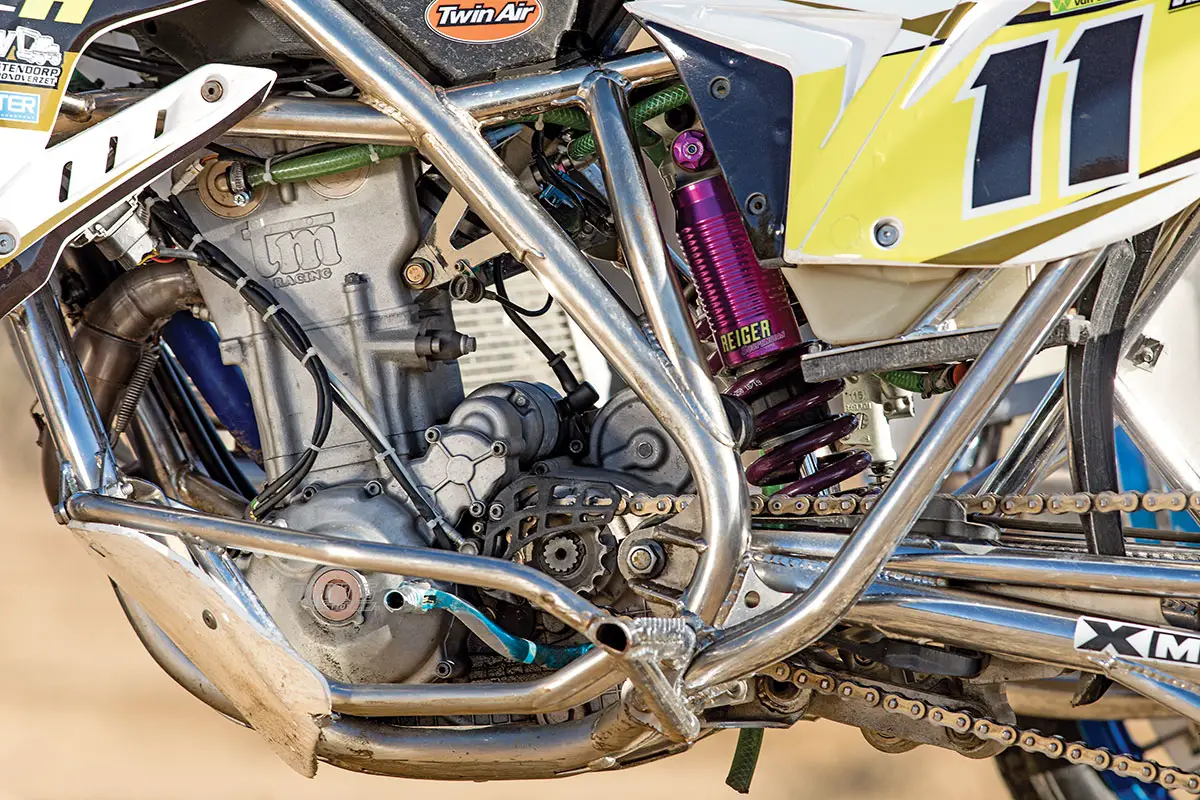



Comments are closed.